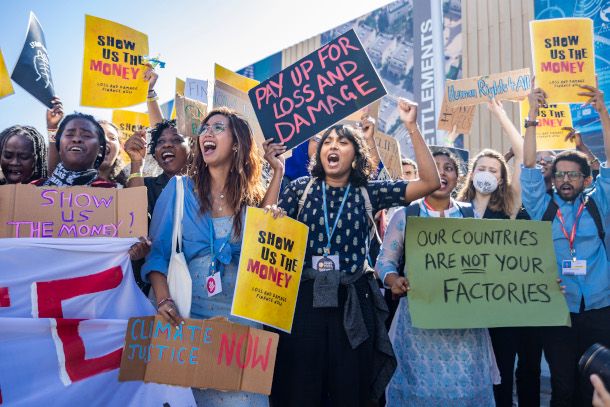COP28 creates fund for vulnerable countries for loss and damage from climate change—but will it reach vulnerable people?
By Zoha Shawoo, Inès Bakhtaoui, Ayesha Dinshaw | December 6, 2023
 Climate activists hold signs demanding compensation for loss and damage. (Mídia NINJA Copyright: (CC BY-NC 4.0) Mídia NINJA)
Climate activists hold signs demanding compensation for loss and damage. (Mídia NINJA Copyright: (CC BY-NC 4.0) Mídia NINJA)
Vulnerable countries and communities are already facing loss and damage from a variety of climate change impacts, including floods, drought, and sea level rise. They urgently need financial support to enable recovery from trauma and lost homes, lives, and livelihoods.
Responding to this need, the on-going 28th UN Climate Change Conference (or COP28) in the United Arab Emirates has approved a breakthrough decision, setting up a new fund specifically to address loss and damage after a year of negotiations and compromise regarding the fund’s structure, mechanisms, and governance. Rich countries have pledged $655.9 million into the fund so far, although hundreds of billions of dollars are needed per year.
Civil society groups, particularly those from the global south, have long advocated for climate finance to directly reach the vulnerable and marginalized people and communities that are most in need, and for locally led action: to give affected people autonomy and decision-making power over how funds are used. The adopted decision on the new loss and damage fund offers some room for this autonomy and mentions the potential for “small grant funding for communities.”
Here are our recommendations for how the new fund can best address local needs, drawing on findings from our latest report, which gathers lessons from the first 1 million pounds of Scottish government funding pledged for loss and damage finance.
Include mechanisms for locally led grants. The Scottish government provided its loss and damage funding through the Climate Justice Resilience Fund, a Washington, D.C.-based nonprofit. The funding was used for grants for locally led action by non-governmental organizations in Bangladesh, Malawi, and the Pacific region. The Scottish government also provided funding for loss and damage grants around the world through the Loss and Damage Youth Coalition Grantmaking Council.
We find that despite limitations relating to scope and scale, smaller grants that directly reach local organizations can play a critical role in offering immediate assistance, building local capacity, and raising awareness. For instance, many of the grants supported the relocation and reconstruction efforts of families hit by climate disasters. In Bangladesh, one project offered support to “trapped” populations who had lost their homes but could not afford to migrate away from their unsafe temporary shelters.


Consultation processes also identified wider structural gaps that are the responsibility of public authorities, like the marginalization of displaced people, or the lack of public infrastructures on relocation grounds. We see a lot of potential in a bottom-up design process for large-scale response strategies that build on locally led projects funded through smaller grants.
Importantly, the fund should include mechanisms for locally led small grants to complement larger-scale, programmatic finance to governments. This could be accomplished by including a dedicated small grants window directly accessible to local organizations in the design of the new loss and damage fund. Recipient countries of loss and damage finance should also aim to disseminate a share to the local level as part of national recovery plans.
Enable participatory and collaborative approaches. When disseminating the Scottish government funding, the Climate Justice Resilience Fund asked grant partners to employ participatory and inclusive processes that empower affected communities, including marginalized community members, to identify loss and damage priorities and make decisions on how to utilize the funding on the ground.
The recipient communities decided how the grants would be spent according to local consultations with affected households, women, the elderly, young people, disabled people, and indigenous people.
We observed strong alignment with principles of fairness and equity in the resulting projects and the promotion of human rights among participating communities. Local young people were also frequently part of the projects’ implementation teams. Such participatory processes of self-determination tend to promote local ownership and the sustainability of projects long after funding has ended.
The fund should ensure that those most affected have autonomy and agency to define what loss and damage means to them and how to address it according to their own needs and priorities. This could be through having representatives of affected communities on the governance structure of the fund, and by shifting decision-making power to lower levels.
Move away from strict boundaries between streams of finance at the local level. Funders can be preoccupied with separating what activities falls in the realm of adaptation (anticipating and reducing future impacts of climate change) vs responses to losses and damages. When implementing the Scottish government funding, grant partners identified loss and damage as “what goes beyond” adaptation to climate change. In practice, however, many of the activities they implemented could have been labeled as adaptation action.
We find that addressing loss and damage inevitably overlaps with adaptation measures on the ground, and it can be counterproductive to try to draw a clear boundary between the two. For example, recovery and reconstruction cannot be successful without future impact risk assessments, and it is important to build the resilience of communities to future impacts as they are recovering from loss and damage.
The fund should find ways to ensure that adaptation and response to loss and damage can be funded jointly without creating burdens for the recipient countries and communities. Instead of tying funding to a strict list of activities, funders could let the affected populations spend it as they see fit, as long as it aligns with the objective of ensuring human and environmental well-being, dignity, and the agency of individuals and communities that are suffering from climate impacts. Labeling of the funding as contributing to adaptation, loss and damage response or other objectives could be done at the end of the project, based on its actual allocation and the results of the project.
Include provisions for non-economic loss and damage. Many of the projects funded by the Scottish government wanted to address non-economic aspects of loss and damage, especially mental health struggles associated with experiences of climate trauma. However, limited funds and timescale meant that affected communities had to prioritize economic dimensions of loss and damage in a context of survival.
Funders must also consider that cultural and spiritual ties to land play an important role in vulnerable populations’ decision to migrate. For instance, a grant partner in Malawi reported that some families refused to leave their land for fear of abandoning their burial grounds and ancestors who, in their culture, protect them—despite the destruction caused by cyclones Ana and Gombe.
The fund should thus embed provisions for non-economic loss and damage and psychological support at all scales, in combination with addressing economic loss and damage.
The success of loss and damage finance will depend not only on how much funding is raised, but also on how this funding is disseminated and to whom. The final purpose of the new loss and damage fund is to provide much-needed support to the most vulnerable people and communities. COP28 should ensure that local needs and priorities are at the heart of how the loss and damage fund is operationalized.
Together, we make the world safer.
The Bulletin elevates expert voices above the noise. But as an independent nonprofit organization, our operations depend on the support of readers like you. Help us continue to deliver quality journalism that holds leaders accountable. Your support of our work at any level is important. In return, we promise our coverage will be understandable, influential, vigilant, solution-oriented, and fair-minded. Together we can make a difference.
Keywords: climate conference, climate reparations, cop28, loss and damage, un conference of parties
Topics: Analysis, Climate Change

















How will the funding to countries be monitored to insure that the funding is used as intended. Where is the transparency? How can this be controlled and substantiated? “funders could let the affected populations spend it as they see fit, as long as it aligns with the objective of ensuring human and environmental well-being, dignity, and the agency of individuals and communities that are suffering from climate impacts.”
It has always been apparent that only a small amount of funding sent to poor people ever receive it, the fi0rst group that controls the funds rips it off!